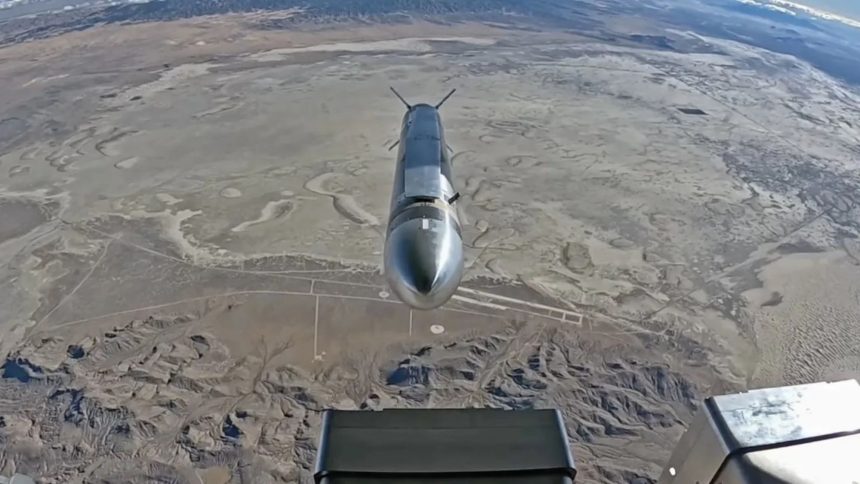The Black Arrow Small Cruise Missile flew for an extended period, meeting all test objectives, with further test and evaluation activities scheduled throughout 2025.
Leidos recently disclosed that, in November 2024, it successfully completed a guided flight test of its Small Cruise Missile (SCM), also known as Black Arrow, from an AC-130J Ghostrider gunship. The “Guided Flight Test 1” validated the “aircraft compatibility, system performance, waypoint uplinks, guidance accuracy as well as integration with the Naval Surface Warfare Center Battle Management System (BMS),” said the company.
The system has advanced beyond its “captive carry and store-safe separation flight tests” conducted in December 2023—first announced in October 2024, when the future “guided flight test” was also revealed. That test took place a month later, in November 2024. Both phases of testing were carried out using an AC-130J.
The project is a CRADA (Collaborative Research and Development) effort between Leidos, the USSOCOM (United States Special Operations Command) and AFSOC (Air Force Special Operations Command), overseen by the USSOCOM’s PEO-FW (Program Executive Office-Fixed Wing).
[NEWS] Leidos completes successful test launch of a Small Cruise Missile.@Dynetics pic.twitter.com/8H9K7XqXHt
— Leidos (@LeidosInc) March 31, 2025
The test
Leidos describes the Black Arrow as a “low cost, 200 pound class mission adaptable delivery platform designed to facilitate spiral upgrades for both kinetic and non-kinetic missions.” The description suggests that the missile is a modular system with swappable guidance, seeker and navigation modules for various mission needs, some of which might also involve SEAD/DEAD (Suppression/Destruction of Enemy Air Defense) with radar baiting and decoy systems.
It appears that the missile was tested only for its kinematic capabilities as the video mentioned the SCM “flew for an extended period meeting all test objectives, including range, duration and terminal accuracy.” The expected performance benchmarks for these attributes have not yet been disclosed.
However, Leidos has confirmed it is now “under contract with USSOCOM” for additional “test and evaluation activities throughout 2025.” These potentially broader tests are expected to assess the individual and integrated performance of the missile’s seekers, guidance system, navigation, and—if included—mid-course update capability.

The video shows the SCM being released from a palletized system, known as the Ramp Launch Tubes (RLT) on the AC-130J gunship’s open ramp. The missile is released by rolling it off tail-first. Once clear of the ramp, the missile’s tail fins deploy, while the wing, a single piece mounted on the top of the body, rotates to the flight position.
The video then shows the missile travelling towards the designated area after the engine ignites. It is unclear what type of propulsion is used, and the InfraRed camera footage does not allow to identify it. Air intakes, if any, are not visible, although this type of weapon usually employs a small jet engine or a rocket motor.
The missile is not shown hitting any target, but is captured from different angles and distances, presumably from an EO (Electro-Optical) system on board the AC-130J. It is being reported, however, that the SCM conducted the entire flight profile including the impact against an unknown target.
Missile capability
While cheap, modular and scalable mass is one thing, the ability to receive and trade targeting updates mid-flight is key and a vital feature for new generation weapons. This would otherwise restrict the missile to attacks only against known fixed targets, requiring days, if not weeks, of prior reconnaissance, surveillance, without the ability to engage targets of opportunity.
Leidos says it has employed “model-based system engineering practices” to achieve “timely and cost-effective development” of the Black Arrow. Utilizing “Air Force-advocated architecture standards” and the Air Force Research Laboratory’s Weapon Open System Architecture in the design would allow rapidly modifying, swapping or upgrading sections on the missile, possibly without having to depend on the primary contractor, in this case Leidos.

“Aligning to these stringent standards, while successfully demonstrating this capability from an operational aircraft, places us in a strong position to rapidly field Black Arrow if called upon,” Leidos’s senior vice-president for Missile and Aviation Systems Mark Miller said. Beside an RLT launch from cargo aircraft, the Black Arrow can also be launched from a palletized system and “conventional store release from fixed-wing aircraft.”
The palletized launch could find use with the U.S. Air Force and the AFRL’s Rapid Dragon project. The weapon of choice here is currently the larger AGM-158 JASSM. The smaller Black Arrow, taking less space on the aircraft, can be fired in larger numbers, or even in a paired coordinated launch with the JASSM.
The possibility of testing Black Arrow on the F-15E Strike Eagle or the newer F-15EX cannot be ruled out, since they are also envisioned to operate as “bomb and missile trucks” in future scenarios. Leidos’ statement added that the Black Arrow met the needs of “affordable mass” that the SCM CRADA sought since it was formed in 2022.
The Dec. 2023 trials already confirmed “digital twin predictions of safe separation, benign store dynamics, and trajectory characteristics.” Further testing “demonstrated integration with the Naval Surface Warfare Center Battle Management System (BMS), operational flight software function, navigation performance, and flight safety system functionality.”
[NEWS] Leidos announces the ‘Black Arrow’ has successfully completed first tests. https://t.co/Uq0d3Ovj4Q
— Leidos (@LeidosInc) October 3, 2024
Affordable, modular mass with shorter kill chains
Miller added in the company’s release that “performing this test from an AC-130 platform while also integrating with the BMS provided aircrews and operators a chance to see how well our SCM worked.” The statement also quoted USSOCOM’s PEO-FW Col. Justin Bronder, who said during the Special Air Warfare Symposium at Eglin AFB in March that the “SCM is a key capability, rapidly advancing AFSOC’s ability to close long-range kill chains.”
The Mitchell Institute of Aerospace Studies has noted an emerging Chinese doctrine to “disrupt elements” in the kill-chain concerned with target acquisition and tracking between the sensor and shooter, rather than engaging the weapon or the launching platform itself. While this could be achieved by advanced EW (Electronic Warfare), a sector where both Beijing and Moscow have made significant strides, longer kill chains in long-range standoff strikes, with several components in the network able to coordinate, are the most vulnerable to this approach.
Black Arrow also arrives at a time when the U.S. military is looking at low-cost one-way attack drones that could double up as cruise missiles for swarming strikes with attritable platforms.









